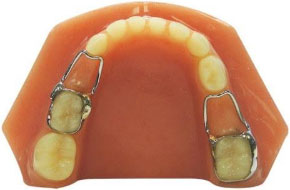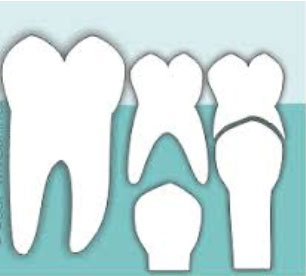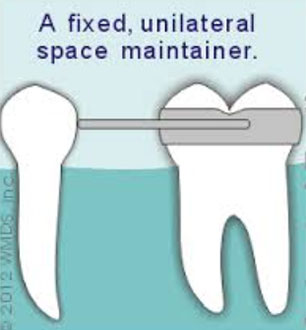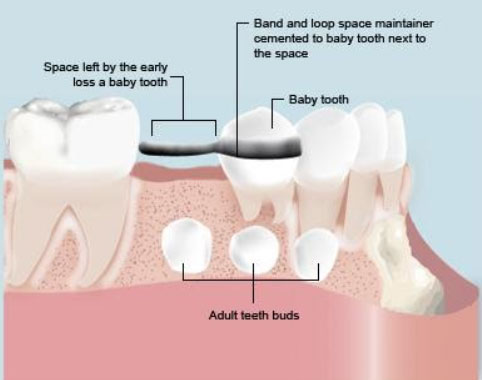Milk tooth removal or baby tooth removal at Dr Kheur Dental Clinics on F.C. Road, Shivajinagar and Nigdi Pradhikaran near Wakad in Pune
The primary (milk) teeth have an important role in guiding the eruption of the permanent teeth. Early loss of primary teeth can lead to undesirable tooth movements resulting in space loss for the permanent teeth to erupt. This can have detrimental effects on developing occlusion (bite) of the child including crowding, impaction or midline discrepancies.
Children may require space maintainers if they lose a tooth early or have a primary (milk) tooth removed due to dental decay. If either is the case, it is important to know the benefits of using a space maintainer for babies and how it can help support the child’s dental health.
If a space is not maintained, then teeth can shift into the open space and orthodontic treatment may be required. Not every child who loses a primary tooth early or to dental decay needs a space maintainer; however, a specialized consultation with the dentist or orthodontist should be conducted to determine if using a space maintainer is needed.
Types of Space Maintainers for children and babies
There are two types of space maintainers for children or babies, removable and fixed at Dr Kheur Dental Clinics on F.C. Road, Shivajinagar and Nigdi Pradhikaran near Wakad in Pune
- Removable – removable space maintainers are similar to orthodontic appliances and are usually made of acrylic. Indicated when there is multiple loss of primary teeth.
- Fixed – there are different kinds of fixed space maintainers: band and loop, crown and loop, distal shoe and lingual arch.
It is important to try and maintain the primary dentition in the arch until exfoliation where possible, however, where early loss is unavoidable this should be managed to minimise the unwanted effects on the developing occlusion. Space maintainers for children and babies can be used for this purpose. In order to be able to consider space maintenance, patients must be dentally fit, have caries removed and motivated to maintain adequate oral hygiene and follow non-cariogenic diet advice.
While there are ways to manage the difficulties associated with space loss through careful orthodontic treatment planning and mechanics. Space maintenance can be especially important in managing and guiding developing dentitions in patients where lengthy orthodontic treatment may not ever be appropriate.
When to space maintain?
Early loss of second primary molars
Preservation of the primary second molar space is key for guiding the eruption of the first permanent molar, otherwise it will shift in the space available leading to space loss and reduction in arch length.
The first permanent teeth to grow are typically the maxillary and mandibular first molars. These molars will erupt behind the primary second molars. Permanent premolars (bicuspids) develop in the place of primary molars.
Generally, second primary molar space should be maintained when the first permanent molars are erupted so they can be included in the space maintainer appliance. When the first permanent molars are unerupted, it would be advantageous to be able to maintain the second primary molar space in order to guide the path of eruption of the first permanent molar into an ideal position.
Wearing the Space Maintainer by children or babies
Once the space maintainer is made by the dentist or orthodontist, it may take the child a few days to get accustomed to wearing the appliance whether it is removable or fixed.
The dentist should review with the child and parent the proper ways to clean the space maintainer thoroughly in order to keep the gum tissue healthy and free of dental plaque. Proper instruction for tooth brushing and flossing should be considered for improved oral hygiene.
Review and removal of space maintainers for children and babies
Once the space maintainer is attached, they should be followed up regularly – initially for oral hygiene reasons as there is an increases risk of plaque accumulation until the patient is able to clean the appliance. This is especially important during the first few weeks. Patients should then be reviewed after a month to ensure the appliance is intact and there are no major problems with wear of the appliance.
Patients should inspect their own appliances, attend review appointments regularly and return as soon as any breakages, loss or slippage occurs. It is advisable to change the method of space maintenance if repeated failures occur.
Generally, the patient should be reviewed at a six-monthly review appointment to ensure the appliance is intact and to monitor the eruption and development of the permanent dentition. Once the permanent successors begin to erupt the space maintainer can be removed.
Maintaining the space may reduce the need for further, lengthy and more complex orthodontic treatment.
How a space maintainer will look in your child’s mouth?





Video Links :
Kids Dentistry
Space Maintaner

LlhVRoTr